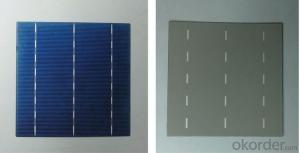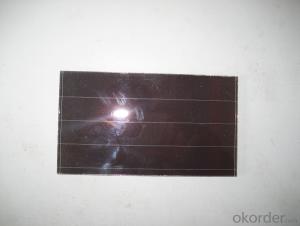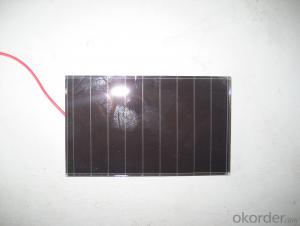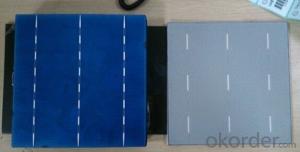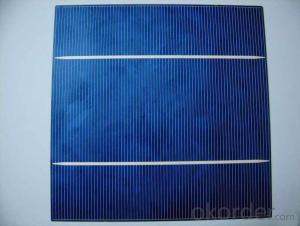Solar Cell High Quality A Grade Cell Polyrystalline 5v 16.8%
- Loading Port:
- Shanghai
- Payment Terms:
- TT OR LC
- Min Order Qty:
- 1000 pc
- Supply Capability:
- 100000 pc/month
OKorder Service Pledge
OKorder Financial Service
You Might Also Like
Specifications
hot sale solar cell
1.16.8%~18.25% high efficiency
2.100% checked quality
3.ISO9001/ISO14001/TUV/CE/UL
4.stable performance
We can offer you the best quality products and services, don't miss !
POLY6'(156*156)
Polycrystalline Silicon Solar cell
Physical Characteristics
Dimension: 156mm×156mm±0.5mm
Diagonal: 220mm±0.5mm
Thickness(Si): 200±20 μm
Front(-) Back(+)
Blue anti-reflecting coating (silicon nitride); Aluminum back surface field;
1.5mm wide bus bars; 2.0mm wide soldering pads;
Distance between bus bars: 51mm . Distance between bus bars :51mm .
Electrical Characteristics
Efficiency(%) | 18.00 | 17.80 | 17.60 | 17.40 | 17.20 | 16.80 | 16.60 | 16.40 | 16.20 | 16.00 | 15.80 | 15.60 |
Pmpp(W) | 4.33 | 4.29 | 4.24 | 4.19 | 4.14 | 4.09 | 4.04 | 3.99 | 3.94 | 3.90 | 3.86 | 3.82 |
Umpp(V) | 0.530 | 0.527 | 0.524 | 0.521 | 0.518 | 0.516 | 0.514 | 0.511 | 0.509 | 0.506 | 0.503 | 0.501 |
Impp(A) | 8.159 | 8.126 | 8.081 | 8.035 | 7.990 | 7.938 | 7.876 | 7.813 | 7.754 | 7.698 | 7.642 | 7.586 |
Uoc(V) | 0.633 | 0.631 | 0.628 | 0.625 | 0.623 | 0.620 | 0.618 | 0.617 | 0.615 | 0.613 | 0.611 | 0.609 |
Isc(A) | 8.709 | 8.677 | 8.629 | 8.578 | 8.531 | 8.478 | 8.419 | 8.356 | 8.289 | 8.220 | 8.151 | 8.083 |
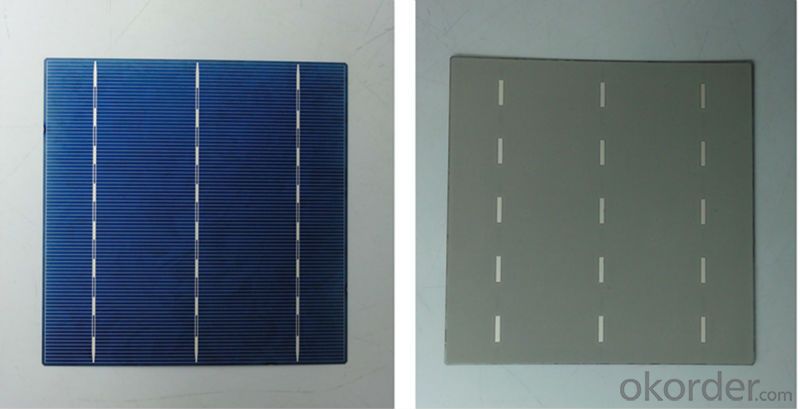
MONO5'(125*125mm)165
Monocrystalline silicon solar cell
Physical Characteristics
Dimension: 125mm×125mm±0.5mm
Diagonal: 165mm±0.5mm
Thickness(Si): 200±20 μm
Front(-) Back(+)
Blue anti-reflecting coating(silicon nitride); Aluminum back surface field;
1.6mmwide bus bars; 2.5mm wide soldering pads;
Distance between bus bars: 61mm . Distance between bus bars :61mm .
Electrical Characteristics
Efficiency(%) | 19.40 | 19.20 | 19.00 | 18.80 | 18.60 | 18.40 | 18.20 | 18.00 | 17.80 | 17.60 | 17.40 | 17.20 |
Pmpp(W) | 2.97 | 2.94 | 2.91 | 2.88 | 2.85 | 2.82 | 2.79 | 2.76 | 2.73 | 2.70 | 2.67 | 2.62 |
Umpp(V) | 0.537 | 0.535 | 0.533 | 0.531 | 0.527 | 0.524 | 0.521 | 0.518 | 0.516 | 0.515 | 0.513 | 0.509 |
Impp(A) | 5.531 | 5.495 | 5.460 | 5.424 | 5.408 | 5.382 | 5.355 | 5.328 | 5.291 | 5.243 | 5.195 | 4.147 |
Uoc(V) | 0.637 | 0.637 | 0.636 | 0.635 | 0.633 | 0.630 | 0.629 | 0.629 | 0.628 | 0.626 | 0.626 | 0.625 |
Isc(A) | 5.888 | 5.876 | 5.862 | 5.848 | 5.839 | 5.826 | 5.809 | 5.791 | 5.779 | 5.756 | 5.293 | 5.144 |

FAQ:
Q:How can i get some sample?
A:Yes , if you want order ,sample is not a problem.
Q:How about your solar panel efficency?
A: Our product efficency around 17.25%~18.25%.
Q:What’s the certificate you have got?
A: we have overall product certificate of ISO9001/ISO14001/CE/TUV/UL
- Q:The meaning of various namesOften heard: low resistance, high resistance, Dummy, wafer, and heavily doped wafer coating film, head of tailing, baffle.Many sayingWhat's the meaning? What's the difference?Please DX me
- Need some wafer to test the state of the art production equipment, such as particle, etching rate, defect rate and so on, these are often called wafer control chip, the control plate is also used to group together with the normal production process to test the quality condition of a process, such as the CVD film thickness. Production equipment in the maintenance or repair immediately after. Production batch of wafer, easy to cause the scrap, and usually use some very low cost wafer to run the process to determine the quality of maintenance or repair work, this type of wafer is called dummy wafer, of course, sometimes dummy wafer also can be used in the normal production process, such as certain machine wafer must process to a certain number the problem with dummy wafer. And some machine must be a form of dummy run in the process of a certain number of wafer, otherwise the process can not guarantee the quality and so on and so on many of the wafer are Dummy. can be called a wafer chip can be basically regarded as a dummy.Dummy wafer, control, block and so on are usually recyclable
- Q:What is a semiconductor silicon device tester
- First of all the circuit insulator carrier plays a supporting role in the insulation layer of the circuit is called the substrate (like P type semiconductor) to participate in the work of the collection circuit to take the CMOS process Nmos substrate are connected with the substrate
- Q:Are there any advancements in solar silicon wafer technology?
- Yes, there have been significant advancements in solar silicon wafer technology. Researchers and manufacturers have been working on improving the efficiency and cost-effectiveness of silicon wafers used in solar cells. Some advancements include the development of thin-film silicon wafers, which require less material and energy during production, and the incorporation of new materials and processes to enhance the conversion efficiency of solar cells. These advancements aim to make solar energy more affordable and accessible for a wider range of applications.
- Q:How do solar silicon wafers handle extreme weather conditions like hailstorms?
- Solar silicon wafers are designed to withstand extreme weather conditions, including hailstorms. These wafers are made of durable materials, such as crystalline silicon, which provide them with the necessary resistance against impacts from hailstones. Additionally, solar panels are often tested and certified to meet international standards that ensure their resilience to various weather phenomena, including hailstorms.
- Q:Can solar silicon wafers be used in thin-film solar cell technology?
- No, solar silicon wafers cannot be used in thin-film solar cell technology. Thin-film solar cells use different materials, such as amorphous silicon, cadmium telluride, or copper indium gallium selenide, to capture sunlight and convert it into electricity.
- Q:How does the efficiency of a solar silicon wafer change with shade?
- The efficiency of a solar silicon wafer decreases significantly with shade. Shade blocks the sunlight from reaching the solar cells, reducing the amount of energy that can be converted into electricity. Even a small amount of shade can have a significant impact on the overall efficiency of the solar panel.
- Q:Are there any ongoing research efforts to enhance the efficiency of solar silicon wafers?
- Yes, there are ongoing research efforts to enhance the efficiency of solar silicon wafers. Various techniques and technologies, such as surface texturing, passivation layers, and advanced cell architectures, are being explored to improve light absorption, reduce recombination losses, and increase overall conversion efficiency. Additionally, scientists are investigating new materials like perovskites and tandem solar cells to further enhance the performance of silicon wafers. Continuous research and development in this field aim to make solar energy more cost-effective and viable for widespread adoption.
- Q:Are there any limitations to the use of solar silicon wafers?
- Yes, there are limitations to the use of solar silicon wafers. One limitation is their high production cost, as the process of manufacturing silicon wafers can be expensive. Additionally, silicon wafers are relatively rigid and inflexible, making it challenging to integrate them into certain applications or structures. Furthermore, the efficiency of silicon wafers can be affected by factors such as temperature and shading, reducing their overall performance. Lastly, silicon wafers are not as efficient at converting sunlight into electricity compared to some other emerging solar technologies.
- Q:How do solar silicon wafers perform in coastal environments?
- Solar silicon wafers generally perform well in coastal environments due to their resistance to corrosion and moisture. However, exposure to saltwater and high humidity levels can potentially cause some degradation over time. Therefore, it is crucial to use high-quality materials and proper maintenance practices to ensure optimal performance and longevity in such environments.
- Q:What is the purpose of surface texturing in solar silicon wafers?
- The purpose of surface texturing in solar silicon wafers is to increase the efficiency of solar cells by reducing reflection of sunlight.
1. Manufacturer Overview |
|
|---|---|
| Location | |
| Year Established | |
| Annual Output Value | |
| Main Markets | |
| Company Certifications | |
2. Manufacturer Certificates |
|
|---|---|
| a) Certification Name | |
| Range | |
| Reference | |
| Validity Period | |
3. Manufacturer Capability |
|
|---|---|
| a)Trade Capacity | |
| Nearest Port | |
| Export Percentage | |
| No.of Employees in Trade Department | |
| Language Spoken: | |
| b)Factory Information | |
| Factory Size: | |
| No. of Production Lines | |
| Contract Manufacturing | |
| Product Price Range | |
Send your message to us
Solar Cell High Quality A Grade Cell Polyrystalline 5v 16.8%
- Loading Port:
- Shanghai
- Payment Terms:
- TT OR LC
- Min Order Qty:
- 1000 pc
- Supply Capability:
- 100000 pc/month
OKorder Service Pledge
OKorder Financial Service
Similar products
New products
Hot products
Hot Searches
Related keywords
